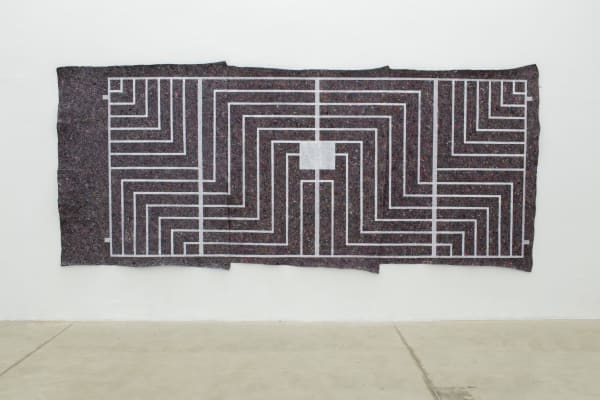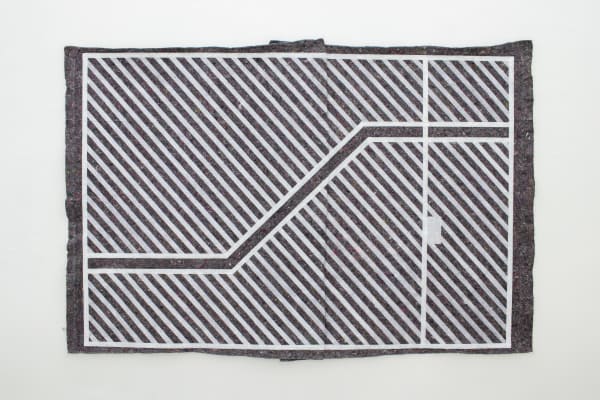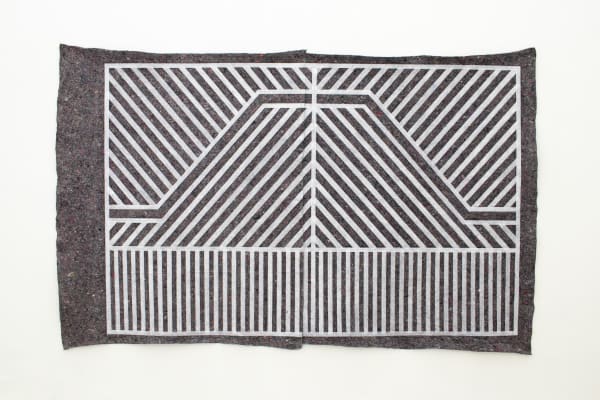Marcelo Cidade: Pânico na Zona Sul
During conversations about the Pânico na Zona Sul [Panic on the South Side] exhibition project, Marcelo Cidade commented: “I swore I'd never use this material again, but we're a long way from not addressing this issue anymore.” The material in question is textile agglomerate - or, as it is better known, donation blanket - made through the reuse of synthetic fibers obtained by processing waste from the textile industry (leftovers from jeans, shirts, shorts) mixed with recycled PET bottles. Searching the internet, it is possible to find advertisements pointing out that the product is suitable for “dogs, cats, beggars, and movers,” in an (I hope) uncomfortable equivalence between “preventing scratches on furniture and utensils,” “giving comfort to your pet,” “transporting items” (including works of art), and “warming up people sleeping on the streets.”
Considering these specificities as part of Marcelo Cidade's artistic practice is inevitable. Throughout his career of more than two decades, he has developed a body of work interested in exploring the dynamics of large urban centers, looking at architectural and social issues, as well as street situations and materials that he has observed while walking around the city of São Paulo, where he was born and still lives today. Urban violence, social inequality, and tensions between the public and private spheres are recurring elements in the artist's repertoire. For example, these are echoed in the song by Racionais MC's that gives origin to this exhibition's title.
This universe includes not only blankets (present in the artist's production since 2009), but also metal gates with geometric patterns, very common in São Paulo homes, and which Cidade has collected as images through photographs taken over the years. In the series Sociedade Anônima [Anonymous Society, 2024], five of these gates are reproduced with spray paint on blankets. Here, blankets and gates are like a veil or elements of control, both subtle and striking, which mark the separation between inside and outside, private space and public space, the individual body and the collective body. From a distance, these paintings are eye-catching because of their scale, large enough to leave the viewer undecided as to whether they are life-size reproductions or not. The hardness of the white lines contrasts with the malleability of the material, attached directly to the wall. Viewed from close up, they make us think about the artist's physical investment in making these large-scale paintings, and we also realize that the grey seen from afar is actually made up of different textures and colors from all the materials that were compressed to make the fabric.
Not all gates are anonymous. The largest of them, reproduced in a painting that is almost two meters high and five meters long, was installed at the entrance of the Casa Modernista, located on Rua Santa Cruz in the Vila Mariana neighborhood, on the South Side of São Paulo. Designed by Ukrainian architect Gregori Warchavchik (1896-1972) in 1927 and built in 1928, the residence (which is now being renovated to house the Museu da Casa Brasileira) is considered to be the first work of modern architecture in Brazil. And here we have another recurring path of research in Marcelo Cidade's production: questioning modernist ideals in Brazil, especially their interest in collectivity and their belief in Brazilian economic and social progress, not only by referencing architecture, but also the visual arts.
In Pânico na Zona Sul (Panic on the South Side), the Sociedade Anônima [Anonymous Society] series shares the exhibition space with three works from the Projeto (re)construtivo [(Re)Constructive Project] series, reproducing on blankets iconic paintings by three important artists from Brazil's constructive heritage: Judith Lauand (1922-2022), the only woman to have officially been part of the Grupo Ruptura (São Paulo, 1952) - a landmark of the constructive movement in Brazil; Ivan Serpa (1923-1973), one of the precursors of geometric abstraction in Brazil and teacher of most of the artists who were part of another milestone of that moment: Grupo Frente (Rio de Janeiro, 1954); and Alfredo Volpi (1896-1988), Italian-Brazilian painter from the second generation of modernism, whose constructive nature in painting based on the simplification of everyday forms, such as the flags of the São João festivities, led him to be considered a kind of precursor of the abstract-geometric discussion in Brazilian art.
Seen together, the two series show how Marcelo Cidade juxtaposes urban space and the art world in many of his works. By bringing elements and processes from the street into the exhibition space, or conversely, by using the urban space as a place for artistic intervention, it is as if the artist were betting on the strangeness and discomfort that these displacements cause. They seem to draw attention to how these two spaces, ideally marked by a certain concept of freedom, are strongly governed by systems, conventions, norms, and tools for control and conditioning.
The third work in this exhibition, Hiper memória arquitetônica [Hyper architectural memory] (Galeria Athena, 2024) is an example of this dynamic. On the white front that houses the exhibition space, metal sheets used by the construction industry draw another facade, in reference to a building that occupied the same space in the past. It is like a ghost that inhabits large urban centers, which are constantly changing due to real estate speculation, and it also exists in the art world, historically built on power dynamics and interests that go beyond the field of art itself.
Fernanda Lopes
![Marcelo Cidade Projeto (re)construtivo: Composição, I.S, 2024 Tinta spray sobre cobertor de doação (aglomerado têxtil) [Spray paint on donation blanket (textile agglomerate)] 174 x 193 cm [68 1/2 x 76 in]](https://artlogic-res.cloudinary.com/w_800,h_800,c_limit,f_auto,fl_lossy,q_auto/artlogicstorage/galeriaathena/images/view/7fcbcbe82d6db6b052dba645e20827fbj/galeriaathena-marcelo-cidade-projeto-re-construtivo-composi-o-i.s-2024.jpg)








